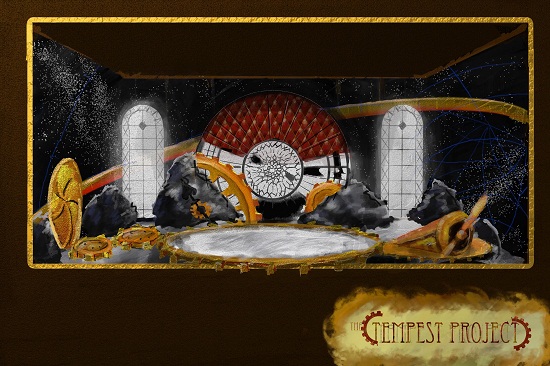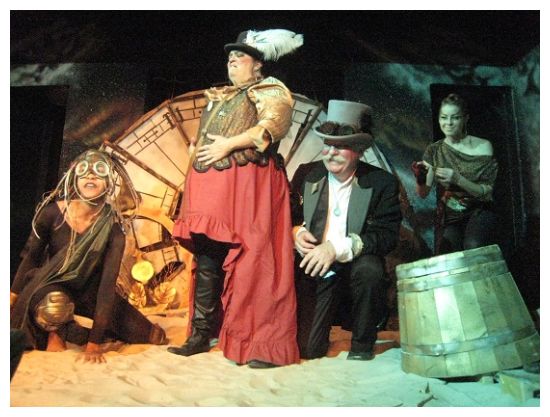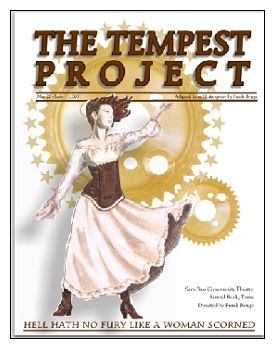Review: The Flair of Sam Bass with The Tempest Project
by Michael Meigs
How much magic can you pack into the box?
The Sam Bass Community Theatre has seats for 52 in that modest structure on Lee Street in Round Rock, north of Austin. The building once served as the Union Pacific depot in town, and one assumes that there wasn't need to serve a lot of passengers. So this theatre can entertain a maximum of just a few more than 200 persons during each week,or about 800 during the course of the usual run. That will be the equivalent of two nights' capacity at the Zach's new Topfer Theatre, or just about 2½ nights at Travis High School performing arts center, where The Mikado has been playing.

Writing recently about the current remarkable season of Shakespeare in Austin, I called the Sam Bass "the little theatre that could," echoing the children's book about the little engine that huffed and puffed and made it to the very tip top of the mountain.
Frank Benge's steam punk adaptation of The Tempest ran from May 20 to June 11. It was a triumph of concept and design, bringing into focus the astonishing talent on display at this modest but long-running theatre.
"Steam punk," I discovered probably much later than the rest of the culutre, is a sub-genre of science fantasy that depicts adventures in a quasi-Victorian world dominated by steam power. I'd had little exposure to this literary field, which developed in the 1980's in frank imitation of the adventure romances of Jules Verne, H.G. Wells and others. Adapter and director Frank Benge came across it for the first time in an advertisement on AustinActors.net for a set designer to create a "steam punk" bar. He investigated and conceived the idea of doing Shakespeare's The Tempest in steam punk mode.
Frank was not the first, as it turns out. Grossmont College in San Diego did a steampunk Tempest in October, 2009. In November of 2010 the high school in Rockwall, Texas, north-east of Dallas, did one. Both those Tempests disappeared without leaving a review discernible by Google. But I'll bet that neither of them showed anything approaching the design flair we saw in Round Rock a couple of weeks ago.
Here's the elevation drawing by Kevin Scholtes, set designer -- a conceptual sketch of the stage as seen from the audience.
One thing that's not obvious in the sketch is the fact that the theatre imported about a ton of white sand to cover the stage area. Carefully reinforced partitions kept the six inches or so of fine grainy stuff from spilling into the audience. Frank Benge himself admonished us not to put our feet up on those comfortable rests. The translucent entrances left and right are full-size doors.
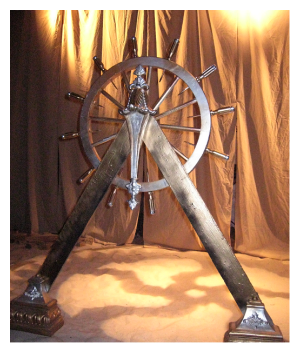
The opening scene of the storm-tossed ship took place before a muslin backdrop, lit to simulate storm conditions, with the set anchored, so to speak, by a single large silver-shining ship's wheel. Closer examination reveals that each of the spikes around the periphery of the wheel is a silver-sprayed screwdriver -- practical for set construction and also evocative of the steam punk "what if" aesthetic. To the audience's right lay a low propeller -- perhaps an auxiliary for the besieged airship, and later, perhaps, representing the crashed ship that brought the scholar Prospera to this deserted isle.
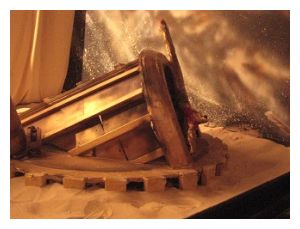
Benge abridged the Shakespeare text somewhat and decided to preserve the Shakespearean speech for the island folk (Prospera, Miranda, Ariel and "Caliba") while giving the shipwrecked visitors a more contemporary idiom. The change gave the piece an exploratory, "steam punk" quaintness and had the advantage of shortening the
playing time somewhat.
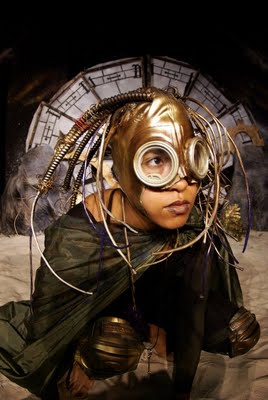 Those elements of creativity joined with the wardrobe imagination and confection skills of Veronica Prior, a long-time member of the theatre and in so-called real life a professional costumer. Prior has always provided fine fabric and fine fantasy when working at the Sam Bass and elsewhere. For this show she connived with designer Scholtes to create some astonishing scenes and costume pieces.
Those elements of creativity joined with the wardrobe imagination and confection skills of Veronica Prior, a long-time member of the theatre and in so-called real life a professional costumer. Prior has always provided fine fabric and fine fantasy when working at the Sam Bass and elsewhere. For this show she connived with designer Scholtes to create some astonishing scenes and costume pieces.
For example, the curiously entomological outfit devised by stage manager Chandra Vargas and worn by Emily Kennedy as "Caliba," bronzed, goggle-eyed and reflecting the sand and hot light of the enchanted isle.
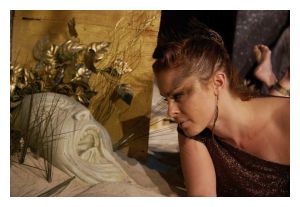 Susan Poe Dickson as a slim, focused Prospera communicated comfortably via a Bluetooth ear-mounted headset with the fairy Ariel (Alicia "Cici" Barone, as mischievous and attractive a sprite as you'll find on any stage).
Susan Poe Dickson as a slim, focused Prospera communicated comfortably via a Bluetooth ear-mounted headset with the fairy Ariel (Alicia "Cici" Barone, as mischievous and attractive a sprite as you'll find on any stage).
Prospera had an office/den at center stage, shielded as appropriate by fanciful display of fan-shaped panels that concealed (as visible behind "Caliba" in the photo to the right) or revealed (see below). From there she oversaw with an stern but indulgent attitude the education of the two very naive youngsters, her daughter Miranda (Carrie Stephens) and shipwrecked prince/suitor Ferdinand (Jason Baiocchi) .
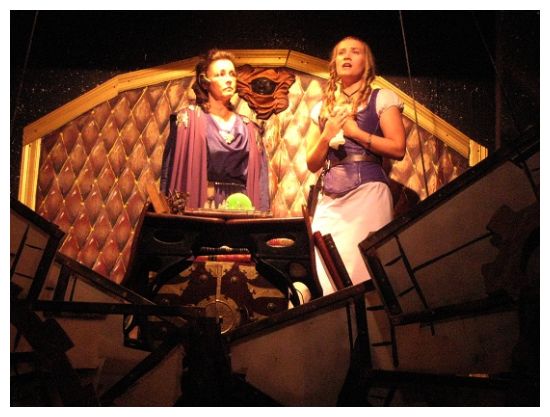
My favorites inevitably were the clown pair Stephano (the serene, smiling Gene Storie) and Trinculo -- or, here, "Trincula," played by Lynn S. Beaver, president of the Sam Bass board. Costume, concept, set and lighting combined to provide an image reminiscent of Caravaggio -- not of that 16th century painter's epoch but similar to some of his visual compositions.
Remarkably, the clowns' fooling was less surprising and amusing when carried out in contemporary speech -- a reminder that the verse strongly sustains character and wit in Shakespeare.
The Tempest Project was deftly executed and definitely entertaining, a demonstration of audacity and imagination. Community theatre in Round Rock provides a season of comfortable box-set comedies and dramas -- and once in a while, to dazzle 'em, a magic cabinet like this one.
EXTRA
Click to view the program for The Tempest Project at the Sam Bass Community Theatre
Hits as of 2015 03 01: 3286
The Tempest Project
by William Shakespeare, adapted by Frank Benge
Sam Bass Theatre Association
